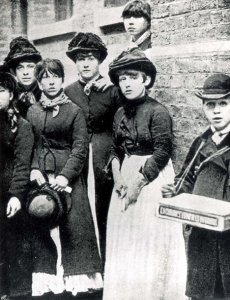In the late 18th and early 19th centuries, Great Britain underwent a major social chance as new manufacturing processes (such as steam and water power and the development of machine tools) began to replace hand production methods. Almost every aspect of daily life was influenced in some way.
The country’s economy grew at an unprecedented rate but this did not improve the quality of life for everyone – especially the working classes.
At the start of the Industrial Revolution, there was no legislation about the working conditions in factories and mills – there had been no need before. As factories got bigger, their owners needed more workers. Children were seen as the ideal workers as they were cheap and too small and uneducated to argue or complain about conditions. In fact, for some tasks, only children could be employed as adults were too big to fit between large machines.
Most children received no education; attending school wasn’t compulsory at the time and most working class families couldn’t afford to send their children to school anyway. For many families, sending their children to work was essential in order to earn the family more money.
Women too underwent huge changes in their daily lives. Working class women were also expected to go out to work. Some worked in the same mines and mills as the rest of their families, but others were able to work for wealthier families as maids or governesses. Despite working, women were still expected to perform most, if not all, of the domestic duties at home.
As the 19th century progressed, workers began to protest against poor conditions in the factories, and demand improved social welfare, labour and political rights, as well as access to education. One of these protests was actually instigated by women on behalf of working girls. In June 1888, public speaker and journalist Annie Besant was horrified to learn about the pay and conditions of women and girls working at the Bryant & May match factory.
Not only were the girls routinely fined for petty offences such as talking, dropping matches or going to the toilet without permission, but their health was severely affected the phosphorous used to make matches. It led to a condition called phossy jaw, which was actually a form of bone cancer that killed many of the girls.
Annie interviewed several girls at the factory and wrote an article for her newspaper, The Link, condemning conditions at Bryant & May. The company responded by attempting to get their workers to sign a statement saying they were happy with working conditions. When a group of women refused, they were immediately sacked. In protest, 1400 women at Bryant & May went on strike.
You can read more about the Matchgirl Strikes here. Thanks to the actions of these brave and determined women and many other social protestors and reformers, conditions for all workers improved, including the creation of age restrictions meaning that children could no longer be exploited as cheap labour.
-Sarah Jackson
Junior Girl
Girl Museum Inc.

